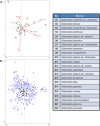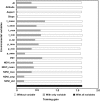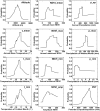Impacts of Environmental Heterogeneity on Moss Diversity and Distribution of Didymodon (Pottiaceae) in Tibet, China
- PMID: 26181326
- PMCID: PMC4504491
- DOI: 10.1371/journal.pone.0132346
Impacts of Environmental Heterogeneity on Moss Diversity and Distribution of Didymodon (Pottiaceae) in Tibet, China
Abstract
Tibet makes up the majority of the Qinghai-Tibet Plateau, often referred to as the roof of the world. Its complex landforms, physiognomy, and climate create a special heterogeneous environment for mosses. Each moss species inhabits its own habitat and ecological niche. This, in combination with its sensitivity to environmental change, makes moss species distribution a useful indicator of vegetation alteration and climate change. This study aimed to characterize the diversity and distribution of Didymodon (Pottiaceae) in Tibet, and model the potential distribution of its species. A total of 221 sample plots, each with a size of 10 × 10 m and located at different altitudes, were investigated across all vegetation types. Of these, the 181 plots in which Didymodon species were found were used to conduct analyses and modeling. Three noteworthy results were obtained. First, a total of 22 species of Didymodon were identified. Among these, Didymodon rigidulus var. subulatus had not previously been recorded in China, and Didymodon constrictus var. constrictus was the dominant species. Second, analysis of the relationships between species distributions and environmental factors using canonical correspondence analysis revealed that vegetation cover and altitude were the main factors affecting the distribution of Didymodon in Tibet. Third, based on the environmental factors of bioclimate, topography and vegetation, the distribution of Didymodon was predicted throughout Tibet at a spatial resolution of 1 km, using the presence-only MaxEnt model. Climatic variables were the key factors in the model. We conclude that the environment plays a significant role in moss diversity and distribution. Based on our research findings, we recommend that future studies should focus on the impacts of climate change on the distribution and conservation of Didymodon.
Conflict of interest statement
Figures





References
-
- Turetsk MR, Bond-Lamberty B, Euskirchen E, Talbot J, Frolking S, McGuire AD, et al. The resilience and functional role of moss in boreal and arctic ecosystems. New Phytol. 2012;196: 49–67. doi: 10.1111/j.1469-8137.2012.04254.x - DOI - PubMed
-
- Imada Y, Kawakita A, Kato M. Allopatric distribution and diversification without niche shift in a bryophyte-feeding basal moth lineage (Lepidoptera: Micropterigidae). Proc Biol Sci. 2011;278: 3026–3033. doi: 10.1098/rspb.2011.0134 - DOI - PMC - PubMed
-
- Frego KA. Bryophytes as potential indicators of forest integrity. Forest Ecol Manag. 2007;242: 65–75.
-
- Ceschin S, Aleffi M, Bisceglie S, Savo V, Zuccarello V. Aquatic bryophytes as ecological indicators of the water quality status in the Tiber River basin (Italy). Ecol Indic. 2012;14: 74–81.
-
- Ermakova EV, Frontasyeva MV, Steinnes E. Air pollution studies in Central Russia (Tula Region) using the moss biomonitoring technique, INAA and AAS. J Radioanal Nucl Ch. 2004;259: 51–58.
Publication types
MeSH terms
Associated data
LinkOut - more resources
Full Text Sources
Other Literature Sources

